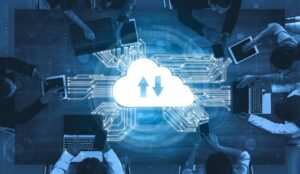Have you ever discerned the rapid changes in technology over the past few years?
Let’s delve into a specific case:
Before the expeditious advancement in technology, people used to save records or any kind of information manually, using pen and paper or typewriters. As time goes by, the pen and paper practice transformed into the electronic approach i.e. Computers, containing applications like Notepad and Word to write, edit, and save documents on hard drives, floppy disks, and CDs. With the widespread adoption of digital technology, tiny portable devices were launched to carry a large number of information i.e. Memory Cards and USBs which made the technology more prevalent.
Today, technology has enabled users to store and access their files and documents without the physical limitations of traditional storage devices like USB drives through the innovation of Cloud-based storage systems. They do not have to carry any device or should exist at specific locations instead they can access their assets virtually.
What is Cloud Computing?

Cloud computing is a technique that provides on-demand services by cloud providers over the internet. Here, on-demand means “an individual’s particular usage requirements” so that whenever users want to access some files, they can use the platform at any time and from any location. Furthermore, infrastructure costs and maintenance are the hassles of cloud providers. Users do not have to worry about them; instead, they just need a strong internet connection.
Let’s explore an instance to make you understand the concept in a finer way:
If you are a programmer and you need a platform to execute the code, then it is necessary for you to install the software for the coding. The performance of the software depends on the size of the machine, storage, and the number of processors. While using an online platform, there is only a need for an INTERNET connection. There is no issue of running out of storage as well because everything is being saved on virtual servers that can be accessed remotely.
Real-Time Usage of cloud computing:
In some regions, there are people who are using the power of cloud computing, but they are not aware of it or have had no exposure to what technology term is behind the veil.
How?
Let’s have a look:
Google Photos and Google Drive are both familiar terms, as people are now moving towards these services instead of keeping their belongings in a gallery or on USB drives. The benefit of this cloud-based service is obvious: if you lose your phone or laptop, you can access your data and retrieve it using any other device. The storage of these services provided by Google is unlimited in comparison to the storage of phones and laptops.
Types of Cloud Computing
⦁ Private Cloud
A private cloud is dedicated purely to one organization rather than being shared among multiple users and companies. An organization that has a private cloud has its own infrastructure, such as networking equipment, physical servers, and virtualization technologies in its own data center whether it is located within that organization or at the data center of a third party that is linked to that specific organization.
⦁ Public Cloud
A public cloud is shared among multiple users and companies, with their infrastructure situated at the data centers of cloud providers. Although, users have access to the same pool of computing resources, their data, and applications are logically isolated and kept separate from other tenants to ensure security and privacy.
⦁ Hybrid Cloud
In a hybrid cloud setup, organizations have the flexibility to determine where to host their workloads and data based on factors such as security, compliance, performance, and cost requirements. They can choose to keep sensitive data and critical applications in a private cloud while utilizing the scalability and cost-effectiveness of the public cloud for other non-sensitive workloads.
Models of Cloud Computing
⦁ Infrastructure As A Service (IAAS)
⦁ Platform As A Service (PAAS)
⦁ Software As A Service (SAAS)

Infrastructure as a Service (IAAS):
Today, businesses are increasingly turning to cloud computing technology to optimize their IT infrastructure and streamline operations. Among the various cloud service models available, Infrastructure as a Service (IaaS) stands out as a powerful solution that offers scalability, flexibility, and control over the underlying infrastructure.
For Example:
If an e-commerce company is facing difficulty on its website during peak times due to an overload of traffic, which can crash the server down and result in a great loss for the company. However, by adapting this feature of cloud computing, they can easily scale up their virtual server instances, storage, and network resources to handle the increased website traffic. This ensures that their website remains responsive, preventing any slowdowns.
Additionally, the company can take advantage of the robust security measures provided by the IaaS provider. They can implement encryption protocols, access controls, and intrusion detection systems to protect their sensitive customer data
Companies that use this service:
⦁ Alibaba Cloud
⦁ AWS Cloud
⦁ IBM Cloud
⦁ Microsoft Azure
⦁ Google Cloud Platform (GCP)
Platform as a Service (PAAS):
This model frees developers from the complexities of infrastructure management, allowing them to focus on coding and application development. PaaS providers handle the following:
⦁ The underlying infrastructure
⦁ Operating Systems,
⦁ Middleware
providing developers with ready-to-use platforms and tools to build their applications.
Examples:
Heroku plays a role as a cloud platform and supports the term Platform-As-A-Service which provides a fully managed environment for creating and deploying websites. It supports multiple programming languages like Ruby on Rails, Java, Node.js, and Python. It has made it easier for developers to focus on their application code without worrying about server management or configuration. It provides real-time deployment and scaling capabilities, making it easier for developers to quickly deploy and manage their applications.
Red Hat OpenShift is a containerization platform provided by Red Hat. It offers a PaaS environment that enables users to manage applications using technologies like Docker and Kubernetes. It allows organizations to focus on their application logic and business requirements without getting into the intricacies of managing the underlying infrastructure. It provides features like:
⦁ Automatic scaling
⦁ Load balancing
⦁ Continuous integration
⦁ Deployment (CI/CD) pipelines
Software as a Service (SAAS):
This model of Cloud Computing has made users go with the Pay-Per-Use approach where users pay for the services they use. Its applications are designed to serve plenty of customers using shared infrastructure.
Some popular examples of SaaS applications include:
⦁ Customer relationship management (CRM) systems like Salesforce
⦁ Collaboration tools like Slack
⦁ Project management software like Asana and Trello
⦁ Email marketing platforms like MailChimp
Netflix, the popular streaming service, relies on SaaS for its content delivery and customer management systems. By utilizing SaaS solutions, Netflix can efficiently stream videos to millions of users across the globe while scaling its infrastructure according to demand.
Zoom, a leading video conferencing and communication platform, is another example of a company that uses SaaS. It provides a cloud-based solution for virtual meetings, webinars, and remote collaboration, enabling organizations to connect and communicate seamlessly.
Conclusion
Cloud computing has transformed businesses by enabling remote work, fostering innovation, and accelerating time-to-market for new products and services. It has also provided a platform for emerging technologies such as artificial intelligence, machine learning, and the Internet of Things.
However, organizations need to consider factors such as data security, regulatory compliance, vendor lock-in, and performance requirements when adopting cloud computing. Proper planning, governance, and robust security measures are crucial to ensure a successful cloud strategy.
FAQ’S
Q1: What is the scope of cloud computing?
A: If you are interested in pursuing a career in cloud computing, there are several courses and certifications that can help you acquire the necessary knowledge and skills.
⦁ Certified Cloud Security Professional (CCSP)
⦁ Google Cloud Certified: Cloud Architect
⦁ Microsoft Certified: Azure Administrator Associate
⦁ AWS Certified Solutions Architect
Q2: What are the major benefits of Cloud Computing?
A: Cost Savings, scalability, flexibility, and security.
Q3: Is there any relation between AI and Cloud Computing?
A: Cloud Computing provides storage services that can accommodate large datasets, allowing AI developers to store and manage the data required for training and inference tasks. Cloud storage also enables data sharing and collaboration among teams working on AI projects.

![[Downloader.la]-649b0e8b92f91](https://coderstechnology.com/wp-content/uploads/2023/06/Downloader.la-649b0e8b92f91.jpg)